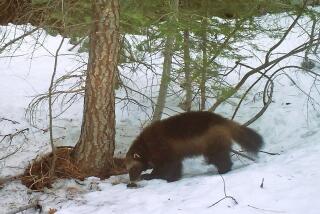Wyoming Rancher Battles State Over Plans for Exotic Animals
- Share via
CHEYENNE, Wyo. — Millionaire rancher John T. Dorrance III is battling the state of Wyoming over the concept of exotic game ranching.
Some wildlife managers predict that game ranching will be an issue of increasing controversy in Western states in the coming years, and so far the battle is not going well for Dorrance.
The 45-year-old Missouri native, whose share of the Campbell’s Soup fortune is estimated at $660 million by Forbes Magazine, wants to bring to his ranch near Devils Tower National Monument about 100 animals from 15 exotic species and 24 animals from four native Wyoming species.
The species include arctic wolves; Russian boar; red, roe, sika, axis and fallow deer; ibex; muntjac; markhor; blackbuck; chamois, and Barbary, mouflon and Marco Polo sheep. The native species he seeks are moose, elk, pronghorn antelope and bighorn sheep.
Dorrance wants to set aside about 4,200 acres of his 17,000-acre ranch for a drive-through wildlife park and to use the animals for hunting, meat production and research on controlling leafy spurge, a virulent weed crowding out natural vegetation on some western ranges.
The Wyoming Game and Fish Commission, citing the threat to native wildlife, has rejected the proposal.
But Dorrance--one of the richest men in America--gives every indication that he is not inclined to accept the decision unchallenged or give up his 20-year dream of an exotic game ranch.
“We’ve got three or four options,” he said. “We can accept it, we can take it into the court system, attack it legislatively to seek some changes in the Wyoming statutes or a combination of the last two.”
He also said he could pursue the ranch in South Dakota or another state with less restrictive laws.
Dorrance stressed that he plans to fully evaluate the financial requirements of his game ranch options before taking further action.
“If we pursue it and win we are still faced with the Wyoming Game and Fish Department,” he said. “They might be very bitter and vindictive. They could make our life impossible.”
Game and Fish Commission President Don Scott said there was nothing personal in the decision, noting that Wyoming law specifically prohibits private importation or possession of native big game animals and bans import of a living wolf from any source.
The permit request for importing the exotics was more controversial, Scott said, but the decision was still clear-cut because of the threats of disease, hybridization and competition for habitat.
He said the commission’s responsibility is to protect the state’s wildlife, and his mail on the issue has run about 150 to 1 against Dorrance’s plan.
“We have wild and free-ranging herds that are truly a national treasure and we just don’t believe that that treasure should be placed in jeopardy--even a remote jeopardy,” he said. “We don’t want to turn Wyoming into Texas.”
Texas has the most widespread exotic game ranching in the nation, and Scott said discussions with wildlife managers in states that allow such ranching indicates “they wish they’d never let them in.”
Officials of the National Wildlife Federation and its Wyoming chapter said they share the Wyoming department’s concerns and support its denial of the game ranching permits.
“Those states that have it are quickly scrambling to see how they can undo what they’ve already done,” said Tom Dougherty, the federation’s regional executive for the Rocky Mountain region. “Colorado is actively pursing legislation and administrative changes relative to some portions of its exotic statutes.”
He said New Mexico has problems with exotics, some introduced by wildlife managers themselves, that are forcing native wildlife out of its habitat.
In both states there is evidence of exotic species crossbreeding with the native wildlife, Dougherty said, and there is some indication that exotics might have spread disease in New Mexico.
“There are examples in every state that, no matter what means are used to contain them, the exotics always escape,” Dougherty said. “When they hybridize with native species, the breakdown in the genetic integrity of both species causes them to become terribly vulnerable to disease.”
Rick Kahn, a wildlife biologist for the Colorado Division of Wildlife, said about 30 escaped mouflon sheep are crossbreeding with bighorn sheep in the Gunnison area, some 75 Barbary sheep are loose near Grand Junction and as many as 100 ibex, Barbary sheep and red deer have escaped from the William Cox ranch along the Colorado-Wyoming border.
“I’m convinced we have more (escaped exotics) than reported,” Kahn said. “There are problems all over and I think exotic species are going to be a big topic for wildlife managers for years to come.”
Tory Taylor, president of the Wyoming Wildlife Federation, said he is concerned about exotics breeding not only with native wild animals but also domesticated farm animals.
Although Dorrance has the resources to provide the best fencing available, Taylor said that’s not enough because human error, vandalism, floods, drifting snow or fires all could lead to escapes.
The Game and Fish Department estimates Wyoming’s wildlife brings the state about $200 million from hunting and fishing annually and Taylor said it is obvious people who only observe or photograph the animals also contribute millions to the economy.
“With the exception of wolves, Wyoming has every species we ever had,” Taylor said. “Some, like the grizzly, the black-footed ferret are very low, but we hope to get them back. To think we run the risk of jeopardizing 100 years of successful game management for the concept of game ranching is just ridiculous.”
Dorrance questions the threat of disease and escapes, saying the animals would be certified disease-free and it would not be in his interest to allow escapes of animals that cost as much as $1,800 each.
“If I wanted to bring in a new strain of cattle from Europe, I wouldn’t have this problem,” he said. “You can go buy untested goats that carry the same diseases and release them in the state.”
He pointed out the domestic livestock raised in Wyoming and some species of game birds are not native to the state, but he acknowledged that they were widespread in the state before there was any organized wildlife management.
Wyoming Agriculture Commissioner Don Rolston and Wyoming Wool Growers Assn. Director Carol Paseneaux share Dorrance’s skepticism about the threat of disease or hybridization, but neither has taken a position on the proposal yet.
“If there is something that can economically benefit the state, I think we should look at it,” Rolston said. “Health has to be considered, but nobody has said yet what diseases these animals would bring in.”
He suggested that the department has quarantine and inspection programs in place to deal with the disease threat.
More to Read
Sign up for Essential California
The most important California stories and recommendations in your inbox every morning.
You may occasionally receive promotional content from the Los Angeles Times.










